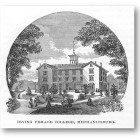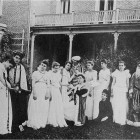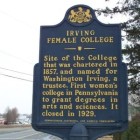The Spotlight Series is an occassional series that highlights interesting people, places, programs, and partner organizations working on historic preservation issues.
During the Civil War, countless Northern soldiers passed through the small town of Mechanicsburg on the Cumberland Valley Railroad. Often, hordes of townspeople turned out to cheer them on; sights not soon forgotten by the new soldiers.
A Reading soldier remembered one sight in particular that delighted the young men of his regiment:
Crowds of people came out to the stations to meet us, and black and white, old and young, all joined in the heartiest demonstrations of welcome. [We] were also greeted from the houses and roadsides all along the line by people waving their handkerchiefs and swinging their hats. At Mechanicsburg a whole girls’ school was out to see us. This was a specially engaging sight to some of our number, who thought that that village would be a good place to camp. Soldiers of a day, we already began, in the midst of these inspiring scenes, to feel like real veterans.
The young ladies who nearly sidetracked an army that day were students at the nearby Irving Female College.
Founded in 1856, the Irving Female College was the first female college in Pennsylvania to grant degrees in arts and science. The school was named for famed author Washington Irving, who served on the board of trustees until his death in 1859. Irving Hall, a large Italianate building, was soon constructed “amongst a beautiful grove and grounds” located along the Cumberland Valley Railroad at the eastern end of Mechanicsburg (an area soon known as Irvington).
Irving Hall could house “forty students, as well as supply the classroom, the parlor,library, and the college offices.” The building was described as having, “…combined all the modern improvements for the promotion of health, comfort, and convenience.” In the early days of the school, the average enrollment was 91 students (many of whom commuted to school from the surrounding region).
By the end of the 19th– century, the College was prospering; a second building was needed. Known as Columbian Hall, the new building “contained 40 additional dormitory rooms on the upper floors and a large auditorium on the first floor.” In 1901, an expanded wing was added to the eastern wing of Irving Hall, creating rooms for music, a kitchen, a cafeteria, and a gymnasium. Ten years later, a substantial President’s mansion was constructed on campus, near the corner of Simpson and Filbert Streets. Built in the Spanish Renaissance style, the mansion was deemed as a proper home to “…entertain the faculty and students and his friends.” The campus also grew by four acres, and was, by that time, landscaped with over 150 ornamental trees. A cluster of the original trees still grows on the front lawn of the campus.
In its hey-day, Irving Female College had buildings that were “…imposing in appearance, substantially built of brick, conveniently arranged, and comfortably fitted up with the modern conveniences, and every thing calculated to make it an attractive and safe home, with full and thorough educational advantages for young ladies.” Some of Irving’s young women would go on to become accomplished alumnae, including Ida Kast, Cumberland County’s first female attorney, Lenore Embick Flower, a notable regional historian, suffragette, and genealogist, and Jane Deeter Ripon, President of the Girl Scouts of America.
The presence of Irving Female College was not just enjoyed by those young Northern soldiers, but by the town as well, as it “…provided Mechanicsburg with a source of culture, music, great literature and drama that the rural town would not have experienced otherwise.” Irving students would regularly put on plays and recitals at the College, which were well attended by the local population. An alumna later said “The college meant a great deal to the community. It was a social center.”
Suffering through the Great Depression, and experiencing increased competition from larger, private universities, and state-funded colleges, the Irving Female College closed and sold its buildings by 1937. Fortunately, shortly thereafter, through preservation and adaptive reuse, Irving and Columbian Halls’ interiors were renovated and converted into apartment space, which they still remain to this day. The President’s mansion however, was demolished in the mid 1980s.
In 1954, recognizing the significance of the school, and urged on by the Irving College Reunion Club, the Cumberland County Historical Association, and others, the Pennsylvania Historical & Museum Commission placed a historical marker in front of the College, near the corner of Main and Filbert Streets.
Later, in 1983, the Irving Female College was listed in the National Register of Historic Places as a significant part of the early story of women’s higher education in the United States.
Sources:
Egle, M.D., William H. An Illustrated History of the Commonwealth of Pennsylvania, Civil, Political, and Military, From it’s Earliest Settlement to the Present Time, Including Historical Descriptions of Each County in the State, Their Towns, and Industrial Resources. Harrisburg, PA: De Witt C. Goodrich & Co., 1876.
Flower, Dawn. “Lenore Embrick Flower.” Cumberland County History, Vol. 10, no. 2 (Winter1993): 81-96.
“Irving Female College.” Pennsylvania Historical Marker Files – Pennsylvania Historic Preservation Office, Harrisburg, PA.
Miniatures of Mechanicsburg. Mechanicsburg, PA: J.A. Bushman Co., 1928.
Reppert, Byron L., Mechanicsburg. Postcard History Series. Charleston, SC: Arcadia Publishing, 2010.
Richards, Louis. Eleven Days in the Militia During the War of the Rebellion; Being a Journal of the “Emergency” Campaign of 1862. Philadelphia: Collins, Printer, 1883.
Rose, Sarah, “Irving Female College National Register of Historic Places nomination form”, 1982. On file at the Pennsylvania Historic Preservation Office, or online through the Cultural Resources GIS (CRGIS).
Thompson, D.W., ed. Two Hundred Years in Cumberland County: A Collection of Documents and Pictures Illustrating Two Centuries of Life in Pennsylvania. Carlisle, PA: Hamilton Library and Historical Association of Cumberland County, 1951.
Comment Policy
PHMC welcomes and encourages topic-related comments on this blog. PHMC reserves the right to remove comments that in PHMC’s discretion do not follow participation guidelines.
Commenters and Comments shall be related to the blog post topic and respectful of others who use this site.
Commenters and Comments shall not: use language that is offensive, inflammatory or provocative (this includes, but is not limited to, using profanity, obscene, or vulgar comments); disparage other commenters or people; condone illegal activity; identify the location of known or suspected archeological sites; post personal information in comments such as addresses, phone numbers, e-mail addresses or other contact details, which may relate to you or other individuals; impersonate or falsely claim to represent a person or an organization; make any commercial endorsement or promotion of any product, service or publication.
If you would like to comment on other topics not related to this blog post but related to PHMC, please fill out the PHMC Contact Us Form.













Have you looked at the former Presbyterian church in Hogestown, built in 1859?
In our online database http://crgis.state.pa.us we do not seem to have information regarding a church in Hogestown. The closest religious facilities we have records for are either in New Kingston or out on Silver Spring Road. Neither of these churches seem to match you description, though. If you would like to provide our office with information about this church, please contact a member of our National Register staff or a member of our CRGIS staff .
The church is located at 6611 Carlisle Pike, (in the donut hole) (Route 11) between two sections, east and west of the pike in Silver Spring Township, Cumberland County. On small lot 60′ frontage and 150′ deep. Built in 1858, it was owned by Trustees for the Presbyterians Worshipping (sic) at Hogestown. It was a church of convenience for the Silver Spring Presbyterians, during its time of service. It continued in other services until 1986(?) Then turned into a cheaply constructed residential unit for one family. Overall interior size is 43′ x 33′. Has been abandoned for nearly two years.
Thank you for this article– my GG Grandmother graduated in 1860 from Irving College.. Esther (Hettie) S Janney.
My GG Grandmother graduated from Irving College in 1860 Esther (Hettie) S Corse (Janney)
My grandmother, Helen M. Kistler, graduated from, and perhaps taught at Irving College, but I do not know her graduation year. Are there lists of alumni and faculty dating back to, approximately, the early 1900’s?
My Grandmother, Millicent Line Kitzmiller, graduated from Irving. I remember her attending reunions which she loved.
My grandmother, Mary Alma nee Young Johnson attended here. circa: 1918.
Hi,
The Spotlight Series: National Register – The Irving Female College offers a fascinating glimpse into a pivotal institution in women’s education history. This historic site not only represents architectural beauty but also reflects the progress of women’s roles in academia. Recognizing it on the National Register ensures its legacy is preserved and appreciated. It’s inspiring to see such places celebrated, as they highlight the importance of preserving our cultural and educational heritage for future generations. sso id